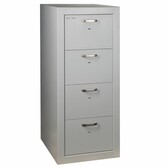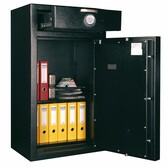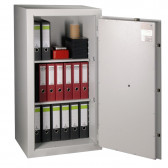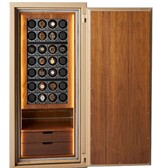Safes provide effective security and protect our valuables, documents and money from theft, fire or other threats. Choosing the right safe can be a challenge, as there are many different types and models available on the market. Which safe to choose? Where is the best place to buy a safe? Which safe will be best for me? What does the security class of the safe mean? These are the most common questions asked by people looking for the right safe for themselves. In this article, we take a look at the different types of safes available from Hartmann Tresore and help you choose – how to choose a safe that will best suit your needs and serve you for many years.
Practicality and versatility
Safes are extremely versatile and universal – available in a variety of sizes, shapes and configurations. This means that they can also be customised to suit individual needs and preferences. For those who value space-saving and expect maximum discretion – we have concealed safes (wall or floor safes), which can be mounted in a recess in the wall or a special hole in the floor (not only discreet, but also do not take up valuable space). For those who need a larger capacity, there are free-standing safes of various sizes and security classes.
Types of safes
Before choosing a particular safe, it is advisable to first familiarise yourself with the types of safes and juxtapose this knowledge with your own needs and priorities. What values are most commonly deposited in safes? Safes are still used to store money, important documents, valuables, jewellery, bullion, collections of all kinds, electronics, data storage media, items of sentimental value, weapons and ammunition.
Think about what you care most about when it comes to a safe – is it the protection of valuables against burglary, fire or comprehensive protection against these threats?
In the following sections of this article, we will look at the specific types of safes, burglary resistance classes, types of locks and more to help you make the right choice. No matter what you want to secure – a safe is the key to increasing your sense of security both at home and in the workplace.
Wall and floor safes
Wall safes and floor safes are an ideal option if you are in the process of building a house, flat or carrying out renovations. They are permanently mounted in the wall or floor, making them difficult to find and therefore difficult to take out or steal. The challenge if you want to build a wall or floor safe is usually having the right place to embed them – it is primarily a matter of having the right thickness of wall or floor, plus we recommend that the safe has at least 10 centimetres of concrete around it. Nevertheless, everything can be designed in advance and it is then possible to seat this type of safe. As for the disadvantages of wall safes – they are not portable, which can be problematic, for example, if you want to move and relocate the safe to a new place. Floor safes and wall safes are available in lower security classes, i.e. they are more suitable for storing smaller values.
Furniture safes
Furniture safes are models that are characterised by a lower security class (usually S1 or S2) and a relatively low weight, which allows the safe to be mounted in built-in furniture – such a safe can even be placed safely on a furniture shelf. Due to the fact that they can be integrated into furniture fittings, furniture safes are (like wall or floor safes) described as discreet solutions, invisible at first glance.
Furniture safes are often used to store smaller values (important documents, small jewellery, cash). They can be installed in a cupboard, chest of drawers, desk or bookcase.
The price of furniture safes is lower compared to burglary safes of higher classes, as these safes are offered in basic security classes.
Burglar-proof safes and strongboxes
If you have items of high or very high value – consider investing in a safe that has a higher security class than S1 and S2. Such safes, by virtue of their design, weight and sometimes size, significantly reduce the risk of the safe being lifted out of its anchored location and unravelled. All safes and strongboxes (security class 0 and above) are characterised by several issues: multi-walled door and body, thick walls, special filling between the walls.
Some burglar-proof safes – due to their size – can be more difficult to conceal, which can be a problem when trying to hide the safe from thieves, but here security is primarily determined by weight (such safes weigh up to more than 2,000 kg).
Document safes and classified metal filing cabinets
These are ideal products for wherever documents are stored. Thanks to the use of more shelves, document safes make it possible to store contracts, deeds, employee files, invoices, etc. in an orderly manner. That is, all documents available in hard copy.
It is worth noting a particular feature that document safes can have, namely fire resistance. By securing your documents in safes with enhanced fire resistance, you are assured that they will not be destroyed even in the occurrence of a fortuitous event such as a fire.
Safes not only protect against theft, but also against other dangers. Fireproof safes are able to protect documents and valuables even in the case of fire.
Properly tested and approved safes can protect our belongings for several tens of minutes, remaining intact in very extreme conditions such as fires.
Drop safes
This is a very interesting category of safes that will be ideal wherever there is a turnover of cash and there may be a turnover of employees. In addition to the standard main door to the safe, drop safes also have an opening, flap or drop drawer – cash is deposited through this element and lands directly in the safe's compartment. Thanks to the use of such a solution, there is no need to open the main door of the safe each time and, in addition, only certain people have access to the deposit.
Key safes
If you work in a company with a lot of keys, then the ideal solution to keep them organised would be a key safe. This is a product that can be easily hung on the wall and can store your keys in an organised manner. Hartmann Tresore also offers 'combination' safes: in the safe in which documents will be stored, we can install a special perforated sheet with holes – you can hang your keys on the hooks.
Gun safes
For enthusiasts of sport shooting or hunting we have a special category of safes and display cabinets with armoured glass. The safes for short and long weapons are equipped with special holders, partitions, shelves and inner safes, which allow the secure and orderly storage of weapons and ammunition.
Premium, exclusive safes
At Hartmann Tresore you have the opportunity to create your own safe. As a manufacturer, we provide the opportunity to personalise and even design a top-quality safe according to your guidelines and expectations.
If you own valuable jewellery, preciosities or automatic watches, you should consider purchasing a safe specifically designed for storing jewellery or watches. These safes have special compartments, inserts lined with material – to avoid scratches and damage to your jewellery. You can place your watches securely and without risk of damage on the watch winders used in the safes.
Locks used in safes
Another important aspect to consider before ordering a particular model of safe is the choice of lock. Safes come with a key lock or locks as standard. The basic price of the safe includes this type of lock. Other kinds of locks that can be fitted to safes are:
• combination locks: the most 'eco-friendly' as they do not require batteries or electricity. The cipher is a certain combination of digits set on a dial. Yes, these are the locks you might see as props in American movies. They are popular, but precision is required in opening a safe with this lock.
• biometric locks: the most advanced solutions. You open the safe by putting your finger on the reader. Of course, the lock must be programmed accordingly beforehand.
Find out what is important when changing the code in the safe.
Burglary resistance class
Safes are tested and certified by independent institutions and organisations for their burglary resistance. The burglary resistance class determines how long a safe can withstand an attack by a thief. The security class determines the so-called RU (Resistance Unit) - this parameter indicates the time it takes to get into the safe (partially or completely) using various types of tools. For example, RU 180/270 (safe class V) means that a thief would need 3 hours to gain partial and 4.5 hours to gain total access to the contents of the safe.
The higher the security class of the safe, the more difficult and the more time it takes to get to the items deposited inside.
Size and capacity
Last but not least is the size and capacity of the safe. Before buying, think carefully about how much space you need to store your valuables. Striking a balance between sufficient capacity and practical size is all the more important because a safe is a purchase that will last for years and over those years valuables will increase – not the other way around.
So if you are considering buying a small safe, for example from the home safes category – we suggest choosing a larger model than the one that seems ideal to you at the moment.
Summary
There are all sorts of safes available on the market, from cassettes to high-end safes (e.g. grade V) and vaults. Remember, however, that small cassettes are not suitable security for valuables. A cassette weighing no more than a few kilograms is even an invitation to a thief – its lightweight construction means that it will easily be stolen and carried away by him.
At Hartmann Tresore, we have class safes – only these will provide a high level of protection for your valuables.
In summary, when choosing the proper safe, you need to consider many factors, such as kind, size, lock type and burglary resistance. It is also always a good idea to consult a security expert or advisor to ensure that your safe meets all your needs. Investing in the right safe is a step towards increasing the security of your valuables and your peace of mind.
Read also: How does a safe work?






